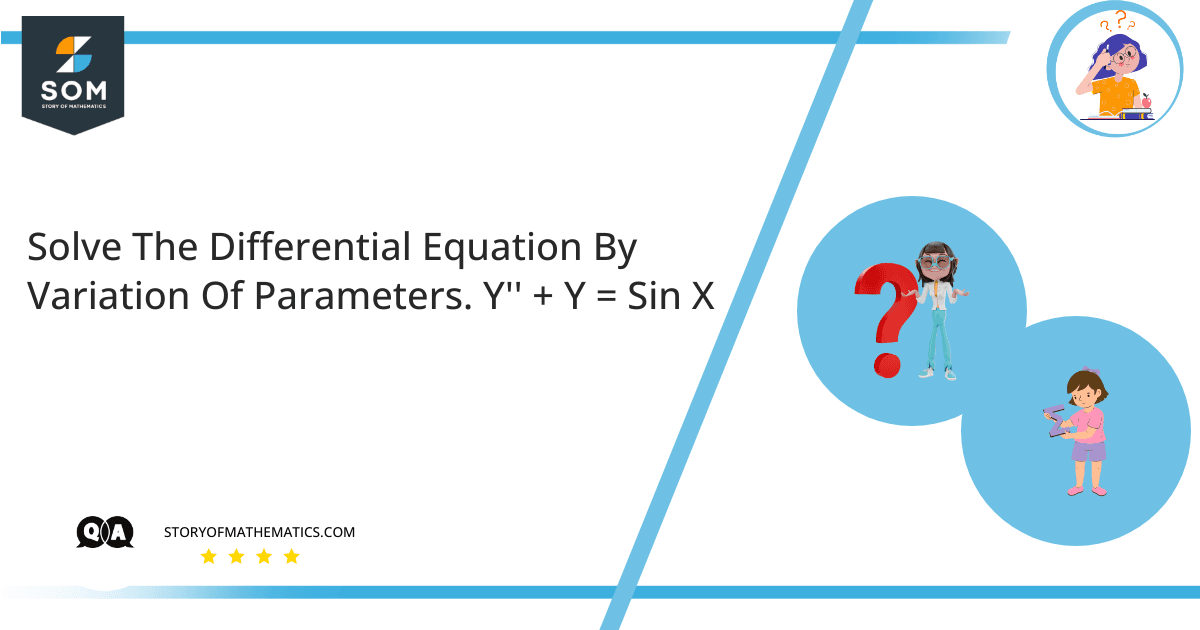
This problem aims to familiarize us with the method of variation of parameters. The concepts required for this problem are related to ordinary differential equations which include general, particular, fundamental solutions and the Wronskian.
We will start by looking at variation of parameters which deals with the equation of the form $\dfrac{d^2y}{dx^2} + p\dfrac{dy}{dx} + qy = f(x)$.
The complete solution can be found using a combination of the following methods:
- – The general solution of $\dfrac{d^2y}{dx^2} + p\dfrac{dy}{dx} + qy = 0$ (homogeneous equation).
- – Particular solutions of $\dfrac{d^2y}{dx^2} + p\dfrac{dy}{dx} + qy = f(x)$ (non-homogeneous equation).
The complete solution can thus be found by adding all the solutions. This approach depends on integration.
Whereas the Wronksian is found when $y_1$ and $y_2$ are the two solutions of the homogeneous equation:
$W(y_1,y_2) = y_1\space y_2`\space -\space y_2\space y_1`$, where $y_1$ and $y_2$ are independent.
Expert Answer
The given equation is:
\[ y“ + y = sinx \]
The characteristics equation for this equation is $r^2 + 1 = 0$, which has roots $r = \pm i$.
The complementary solution of the equation can be found by taking the integral of the main equation:
\[\int y“ d(x) +\int y dx =\int sinx dx\]
\[ y_c = C_1cosx + C_2sinx\]
This complementary solution is split into two independent solutions as:
\[ y_1 = cosx \space \space y_2 = sinx\]
Then we can find the Wronksian as:
\[ W(y_1,y_2) = \begin{bmatrix} cosx & sinx \\ -sinx & cosx \end{bmatrix} \]
\[ W(y_1,y_2) = cos^2x + sin^2x \]
Using the trigonometric identity:
\[ W(y_1,y_2) = 1 \]
Now, solving for $W_1$:
\[ W_1 = \begin{bmatrix} 0 & sinx \\ sinx & cosx \end{bmatrix} \]
\[ W_1 = -sin^2x\]
\[ W_1 = \dfrac{1-cos2x}{2}\]
\[ W_1 =\dfrac{-1}{2} + \dfrac{1}{2}cos2x\]
Now, solving for $W_2$:
\[W_2 = \begin{bmatrix} cosx & 0 \\ -sinx & sinx \end{bmatrix} \]
\[W_2 = sinx + cosx \]
\[W_2 = \dfrac{1}{2}(2sinxcosx) \]
\[W_2 = \dfrac{1}{2}(sin2x) \]
The particular solution is given by the equation $y_p = u_1y_1 + u_2y_2$ found by the integration:
\[u_1 = \int \dfrac{W_1}{W} dx\]
\[= \int \dfrac{\dfrac{-1}{2} + \dfrac{1}{2}cos2x}{1} dx\]
\[= \dfrac{-1}{2}\int dx + \dfrac{1}{2}\int cos2x dx\]
\[u_1= -\dfrac{1}{2}x + \dfrac{1}{4}sin2x\]
Now finding $u_2$:
\[u_2 = \int \dfrac{W_2}{W} dx\]
\[= \int \dfrac{\dfrac{1}{2} sin2x}{1} dx\]
\[= \dfrac{1}{2}\int sin2x dx\]
\[u_2= -\dfrac{1}{4}cos2x\]
Plugging the values:
\[y_p=\dfrac{-1}{2}xcosx + \dfrac{1}{4}sin2xcosx – \dfrac{1}{4}cos2xsinx\]
Now the general solution is the combination of all the solutions:
\[y=y_c + y_p\]
\[y=C_1cosx + C_2sinx – \dfrac{1}{2}xcosx + \dfrac{1}{4}sin2xcosx – \dfrac{1}{4}cos2xsinx\]
Numerical Result
The general solution comes out to be:
\[y=C_1cosx + C_2sinx – \dfrac{1}{2}xcosx + \dfrac{1}{4}sin2xcosx – \dfrac{1}{4}cos2xsinx\]
Example
Without solving, specify the Wronskian value of $2$ solutions for:
$t^4y“ – 2t^3y` – t^8y = 0$
The first thing to do here is to divide this differential equation by the coefficient of the highest derivative as it will yield the solution. This will give us:
\[ y“ – \dfrac{2}{t}y` – t^4y = 0\]
Now using the equation:
\[W(y_1,y_2) \space (t) = ce^{-\int p(t) dt}\]
\[= ce^{-\int – \dfrac{2}{t} dt}\]
\[= ce^{2\ln t}\]
\[=ce^{\ln t^2}\]
\[ W = ct^2\]
